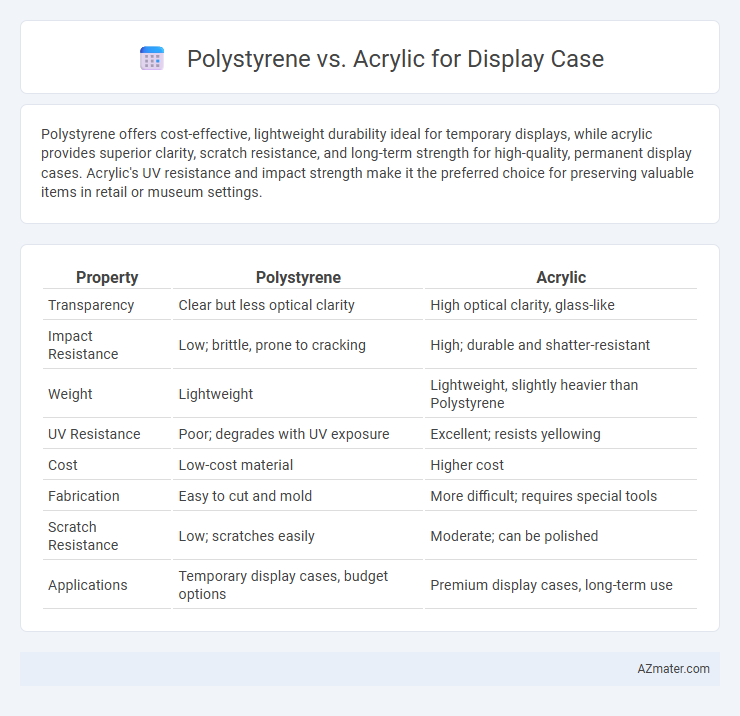Polystyrene offers cost-effective, lightweight durability ideal for temporary displays, while acrylic provides superior clarity, scratch resistance, and long-term strength for high-quality, permanent display cases. Acrylic's UV resistance and impact strength make it the preferred choice for preserving valuable items in retail or museum settings.
Table of Comparison
| Property | Polystyrene | Acrylic |
|---|---|---|
| Transparency | Clear but less optical clarity | High optical clarity, glass-like |
| Impact Resistance | Low; brittle, prone to cracking | High; durable and shatter-resistant |
| Weight | Lightweight | Lightweight, slightly heavier than Polystyrene |
| UV Resistance | Poor; degrades with UV exposure | Excellent; resists yellowing |
| Cost | Low-cost material | Higher cost |
| Fabrication | Easy to cut and mold | More difficult; requires special tools |
| Scratch Resistance | Low; scratches easily | Moderate; can be polished |
| Applications | Temporary display cases, budget options | Premium display cases, long-term use |
Introduction to Display Case Materials
Polystyrene and acrylic are two popular materials used in display case fabrication, each offering unique benefits in clarity, durability, and weight. Polystyrene is lightweight and cost-effective, making it suitable for temporary or budget-conscious displays, while acrylic provides superior optical clarity and impact resistance, ideal for high-end or long-term exhibits. Choosing between polystyrene and acrylic depends on factors such as display environment, protection needs, and budget constraints.
Key Differences Between Polystyrene and Acrylic
Polystyrene is a budget-friendly, lightweight plastic with moderate clarity and impact resistance, making it suitable for short-term or low-risk display cases. Acrylic offers superior optical clarity, higher scratch and impact resistance, and better UV stability, ideal for long-term, high-quality displays. While polystyrene is easier to mold and thus more customizable, acrylic's durability and resistance to yellowing make it the preferred choice for premium display cases.
Clarity and Transparency Comparison
Polystyrene offers excellent clarity with a light transmission rate of around 92%, making it a cost-effective choice for display cases requiring good visibility. Acrylic provides superior transparency, boasting a higher light transmission of approximately 93-98%, resulting in a clearer, more vibrant presentation of displayed items. The enhanced optical clarity of acrylic minimizes glare and improves viewing angles, making it the preferred option for high-end display cases.
Durability and Impact Resistance
Polystyrene offers excellent clarity but is less durable and more prone to cracking under impact compared to acrylic, which provides superior impact resistance and long-lasting durability for display cases. Acrylic's higher tensile strength and flexibility make it ideal for protecting valuable items from physical damage while maintaining clear visibility. Due to its resistance to shattering, acrylic is often preferred over polystyrene for high-traffic or transportable display cases requiring robust protection.
Weight and Handling Considerations
Polystyrene display cases are significantly lighter than acrylic, making them easier to handle and transport during setup or relocation. Acrylic, while heavier, offers greater rigidity and impact resistance, which benefits long-term durability despite the added weight. Handling polystyrene requires extra care due to its tendency to scratch and crack more easily compared to the sturdier acrylic material.
UV Protection and Yellowing Over Time
Polystyrene display cases offer moderate UV protection but tend to yellow significantly over time when exposed to sunlight, compromising aesthetic clarity. Acrylic provides superior UV resistance, maintaining transparency much longer and resisting yellowing, making it ideal for preserving valuable or delicate items. The higher UV stability and durability of acrylic ensure better long-term display quality and visual appearance compared to polystyrene.
Ease of Fabrication and Customization
Polystyrene offers excellent ease of fabrication due to its lightweight nature and ability to be easily cut, glued, and thermoformed, making it ideal for custom display cases with complex shapes. Acrylic, while more durable and scratch-resistant, requires specialized tools for cutting and bonding, which can increase fabrication complexity but allows for high-quality finishes and precise customization. Both materials support customization, yet polystyrene provides more flexibility for quick modifications, whereas acrylic excels in producing polished, professional-grade display cases.
Cost Efficiency and Budget Planning
Polystyrene offers a lower upfront cost compared to acrylic, making it a budget-friendly option for display cases without compromising basic durability. Acrylic, while more expensive, provides superior impact resistance and clarity, potentially reducing replacement and maintenance expenses over time. Careful budget planning should weigh initial material costs against long-term durability and aesthetic value to optimize cost efficiency.
Maintenance and Cleaning Tips
Polystyrene display cases require gentle cleaning with a soft cloth and mild soap to avoid surface scratches and maintain clarity, while acrylic cases benefit from microfiber cloths and non-abrasive cleaners to prevent haze and static buildup. Regular dusting and avoiding harsh chemicals extend the lifespan of both materials, ensuring long-lasting transparency and structural integrity. Proper maintenance minimizes the risk of discoloration and brittleness, essential for preserving the aesthetic appeal of display cases.
Best Applications for Polystyrene vs Acrylic
Polystyrene offers excellent clarity and rigidity, making it ideal for lightweight, low-cost display cases used in retail or museum environments where budget constraints and short-term use are priorities. Acrylic provides superior impact resistance, UV protection, and weather durability, making it the preferred choice for long-term displays, outdoor cases, or high-traffic areas requiring enhanced security and optical quality. Selecting polystyrene benefits applications focused on affordability and ease of fabrication, while acrylic suits professional-grade exhibits demanding robustness and clarity.

Infographic: Polystyrene vs Acrylic for Display Case
 azmater.com
azmater.com